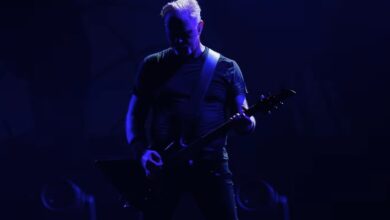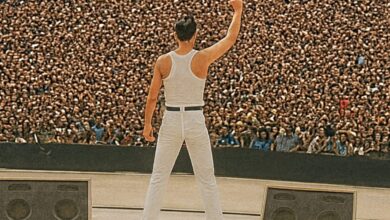The Royal Marines’ Majestic Rendition of “The Sound of Silence” at Royal Albert Hall
At the 2020 Mountbatten Festival of Music, the Royal Albert Hall sank into quiet darkness before a lone clarinetist emerged in a single spotlight. Thousands of eyes fixed forward as the first fragile notes of “The Sound of Silence” drifted across the hall. The atmosphere was hushed yet electric, every breath suspended, as though the audience collectively recognized that something timeless was unfolding before them.
This rendition embraced grandeur, yet it pointed as much toward the future as it did the past. Born in the coffeehouses of the 1960s, the song had since been reborn through Disturbed’s thunderous 2015 cover, which gave it new relevance for a younger generation. In contrast, the Marines’ woodwinds leaned into subtlety, offering a poised response to Disturbed’s raw intensity—an answer wrapped not in ferocity, but in grace.
As the strings rose and wove into the arrangement, the space itself transformed. Brass boomed with cathedral-like resonance, framing the piece in a vast cinematic scale. Where Disturbed’s version struck with sheer force, the Marines’ built their power through patience and balance. The result was a landscape of sound that drew listeners into contemplation rather than confrontation.
Military ensembles are renowned for precision, but here precision took on new meaning. Each pause, each silence, carried weight equal to the notes themselves. It was not mechanical discipline but emotional discipline—pauses deepened the resonance, silences spoke louder than any crescendo. For admirers of Disturbed’s visceral delivery, this alternative gave catharsis of another kind, born of discipline and reverence rather than anguish.
History also deepened the performance’s significance. These musicians were not only performers but soldiers, many of whom had served aboard naval vessels, bringing both comfort and care to their crews. That legacy bled into their playing, reminding the audience that music has long been intertwined with sacrifice. To some, this orchestral voice resonated as hauntingly as David Draiman’s growl—different languages of expression, but the same emotional depth.
The festival itself added layers of gravity. Dedicated to naval tradition and service charities, the evening turned music into remembrance. Those opening notes reminded listeners not only of Simon & Garfunkel’s original but of the soldiers, families, and sacrifices linked to the event’s cause. Disturbed had turned the piece into a meditation on personal struggle; the Marines reframed it as a collective elegy.
Technology carried the echoes far beyond the hall. Clips spread across the internet, where fans weighed the Marines’ solemn majesty against Disturbed’s viral storm. Some praised this version specifically because it rejected spectacle. Its strength was quiet, its authority understated, and that restraint offered comfort to listeners craving peace rather than upheaval.
At the midpoint, the Corps of Drums added a heartbeat of rhythm with steady snare rolls. Yet even with percussion, the arrangement never tipped into excess. Where Disturbed’s climaxes thundered, the Marines showed that subtle crescendos could be just as commanding. Both renditions revealed different dimensions of silence—one brimming with rage, the other glowing with reflection.
Audience reactions revealed the piece’s breadth of impact. Older generations compared it to wartime broadcasts heavy with solemnity, while younger attendees felt the same pull they once felt with Disturbed’s version. Many avoided choosing sides altogether, admiring instead how both interpretations distilled the same emotional essence through entirely different lenses.
The Royal Albert Hall’s acoustics magnified every shade of sound. A triangle’s delicate chime, barely audible at first, rippled outward like light through stained glass. These fine details gave the Marines’ version a unique strength: it did not simply orchestrate the song but turned silence into its own instrument. Where Disturbed filled silence with thunder, the Marines filled it with echoes.
The irony was unmistakable—a song once used in protest against war now voiced at a military gala. Yet the Marines’ interpretation did not feel contradictory. Instead, it created dialogue. Disturbed had given a voice to modern alienation; the Marines transformed the piece into remembrance, an acknowledgment of sacrifices too often left unspoken.
Beyond the concert hall, the Marines carry this song into classrooms, ceremonies, and humanitarian missions. “The Sound of Silence” has become a piece for moments when words falter, echoing how Disturbed’s cover became an anthem for those struggling with isolation. Both renditions speak to human need—some for the raw release of a scream, others for the calm of stillness.
When the last note dissolved, silence lingered for a beat before erupting into thunderous applause. Veterans and civilians alike rose to their feet—some weeping, others cheering in gratitude. Online, debates flared about which version was greater, but beneath the comparisons lay a shared truth: this song transcends form.
Both interpretations leave lasting impressions. Disturbed’s voice reaches those battling inner storms, while the Marines elevate the piece into collective memory. Together, they prove that songs are never fixed relics but living, shifting entities that find new meanings across generations. And perhaps that is why “The Sound of Silence” continues to endure—because whether whispered, shouted, or orchestrated, it speaks truths too profound to ignore.





